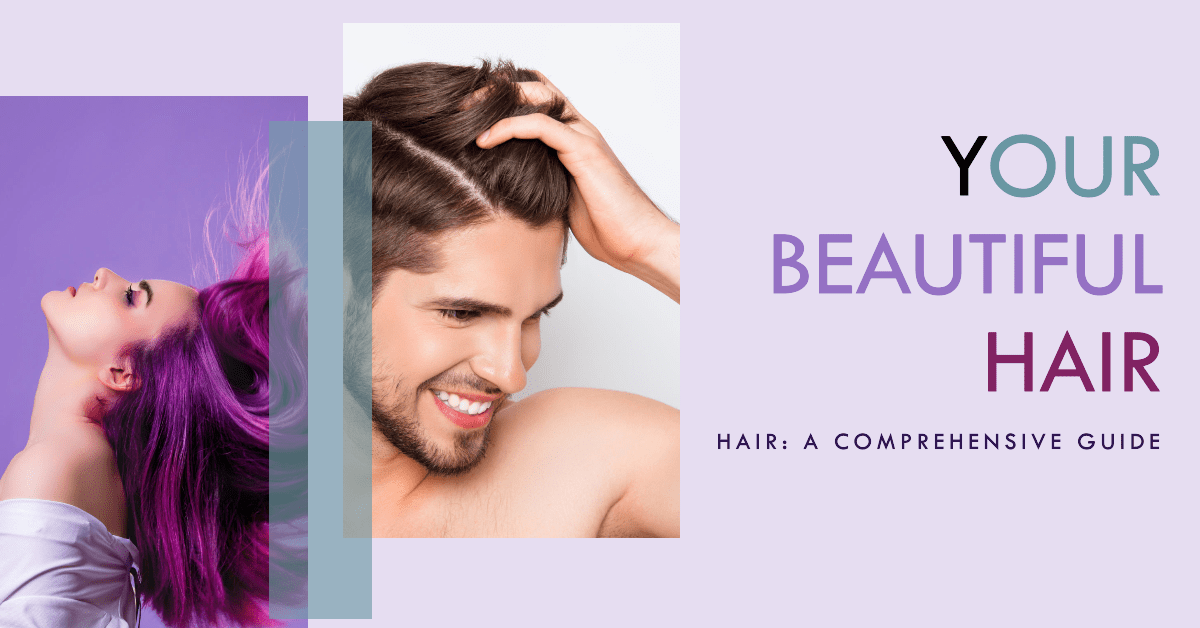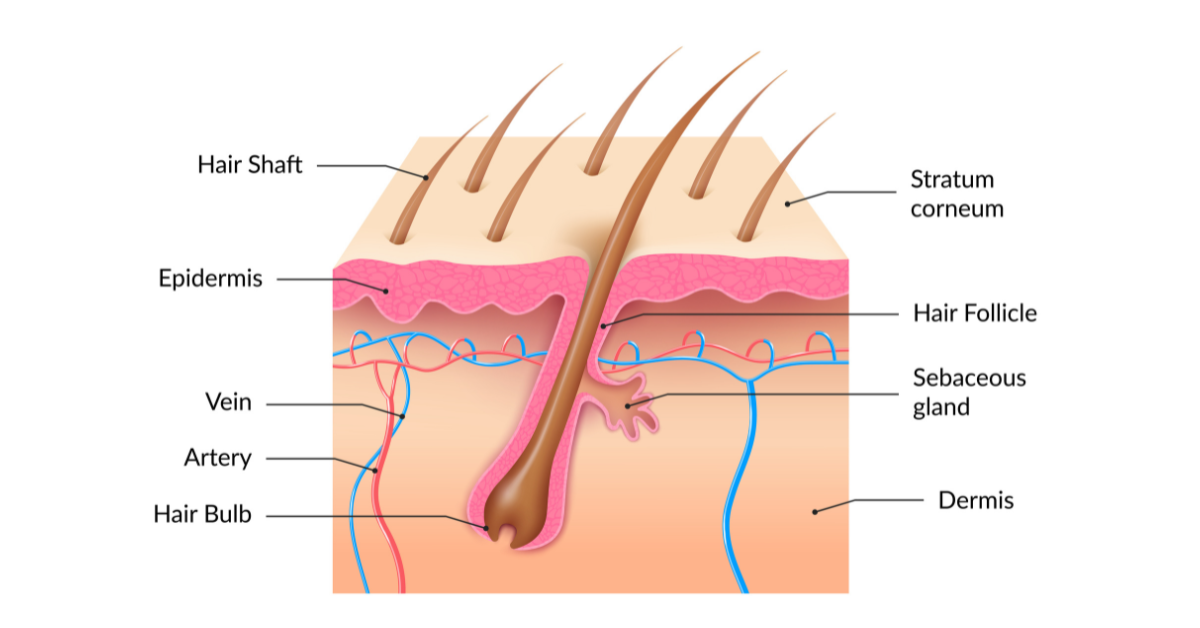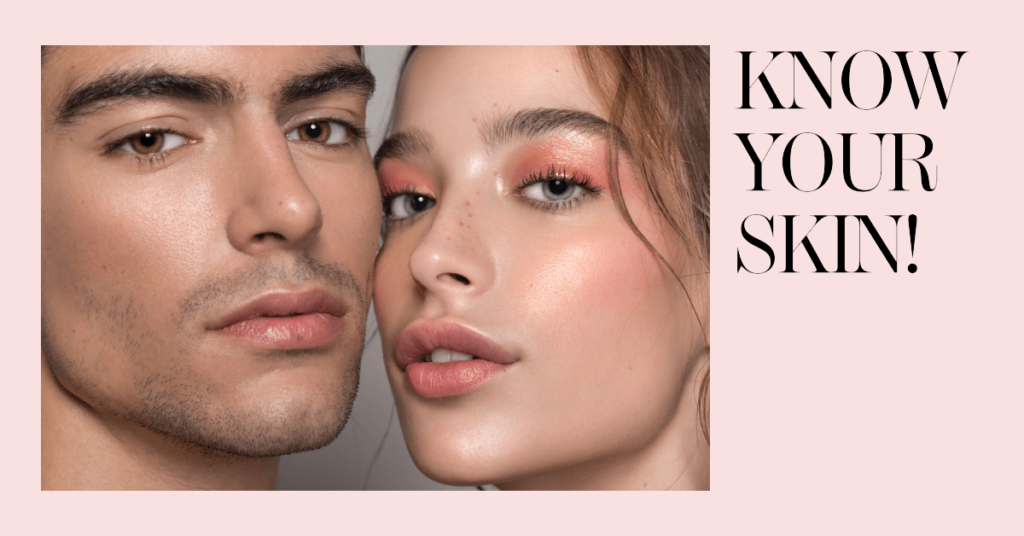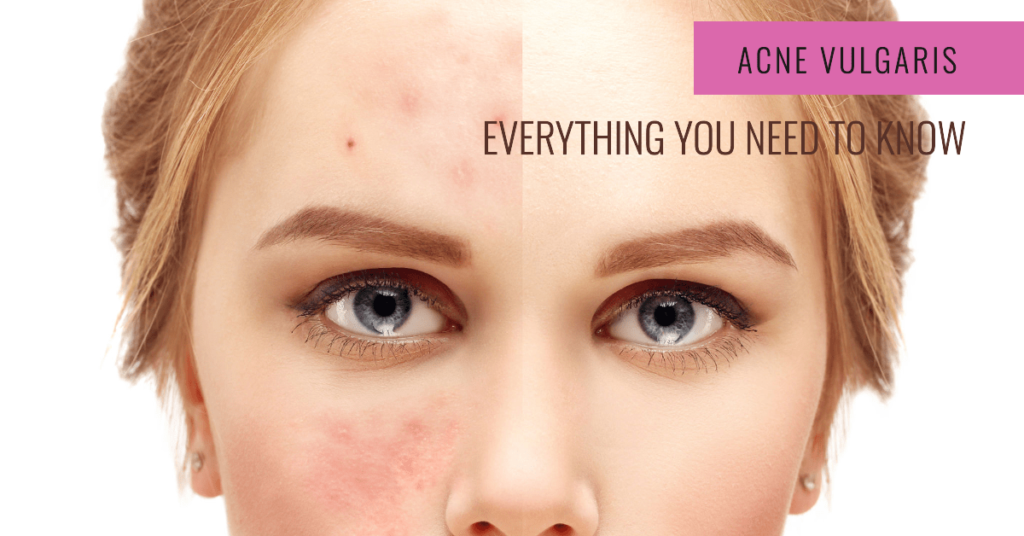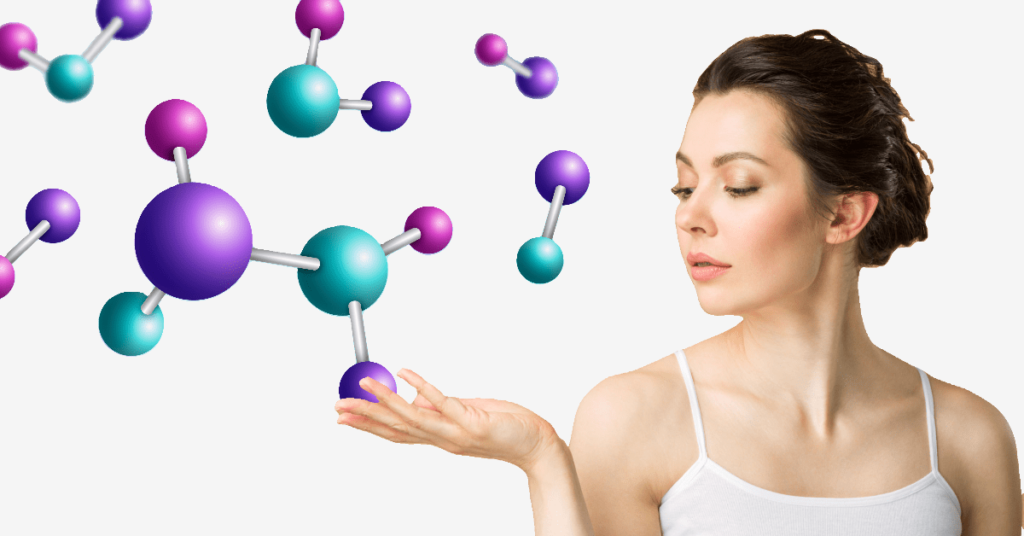You can’t solve a problem without understanding the problem properly. That is why, it is of utmost importance that you understand your hair well; What’s it made of? What’s its role? How it’s grown? etc., before jumping into creating a hair care routine or investing into hair care products which may or may not have any effect on your hair.
Context & Brief of the Topic
Straight, helical, or wavy, black, brown, or white, whichever the hair type, or the color you are, it is made up of a naturally occurring protein called Keratin. A thin flexible tube of dead, fully keratinized epithelial cells that we see on the surface of the skin is called Hair Shaft, however what we don’t see out of these two parts that hair is divided into, is Hair Follicle, a tiny sack within your dermis (middle layer of the skin) from which hair grows. It’s preferred to have basic understanding of Anatomy & Physiology of The Skin to easily understand terminology used here. However, it’s not must.
Knowing your hair not only help you taking the first step towards maintaining healthy & stronger hair, but also adds some extra sugar to your looks because we know, hair has the power to transform your personality. Hair can literally change how you look and how you’re perceived. So, keep scrolling, by the end of this article, you’ll have enough knowledge about your hair to make an informed decision about your hair care routine or a product you are planning to invest in.
Anatomy and Physiology of the Hair
Structurally, hair is divided into two parts mainly; Hair Shaft and Hair Follicle, as shown in above picture.
Hair Shaft: As seen in the picture, hair shaft is the hair that we see and can touch which grows out of epidermis. It’s is made up of a hard protein called Keratin which is also responsible for keeping your hair, skin and nails healthy and strong. Hair Shaft contains the following parts within itself.
- Medulla: This is the innermost layer of your hair shaft which is usually found in thick hair. The main function of this layer is to provide support to the complete structure of the hair.
- Cortex: This is the middle layer of your hair shaft, mainly responsible for providing strength, shine, color and texture to your hair. This is the layer which contains a long chain of keratin, responsible for producing hair. This hard protein gives your hair it’s elasticity, suppleness and resistance etc.
- Cuticle: This is most superficial, colorless layer of your hair shaft which protects medulla and cortex. It is what we see and a healthy cuticle looks smooth with intact scales, reflets most of the light and infuse natural light to your hair as well as provides protection from chemicals and pollutants.
Hair Follicle: This part of the hair resides within your middle skin layer i.e. dermis, as shown in the picture above, which is a tiny sack from which hair grows and surrounded by sebaceous gland, arteries, vein etc. The main function of this follicle is supporting the growth of hair amongst other.
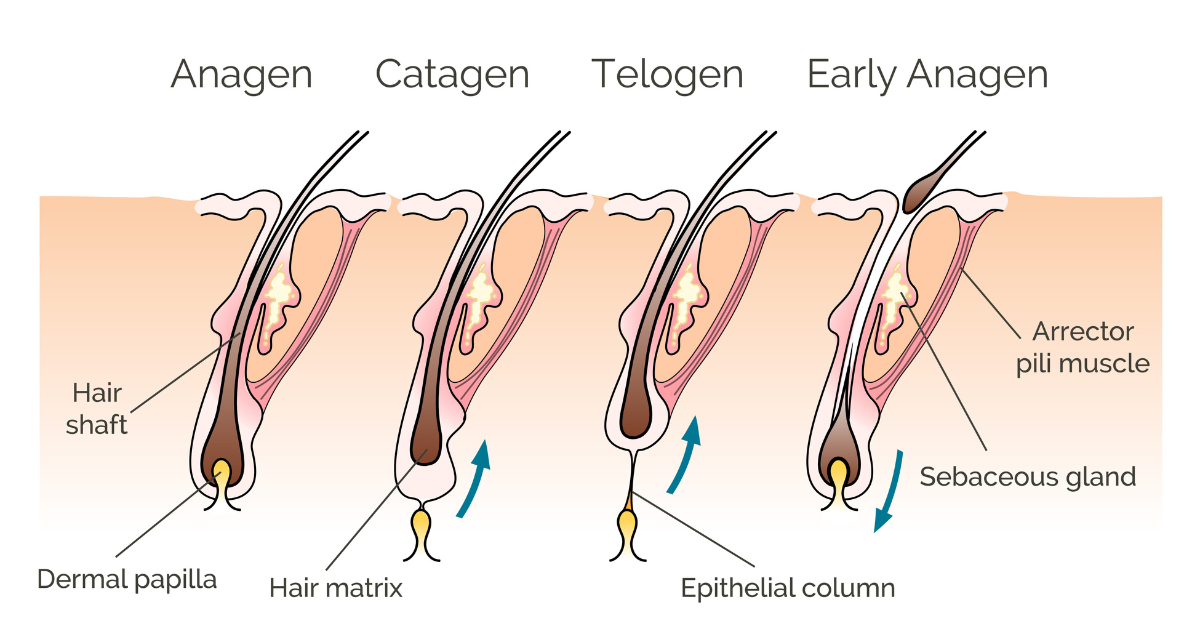
Hair Growth Cycle and The Explanation for Hair Loss
It is okay to shed a few tears hairs on daily basis. This is normal and even healthy because it is part of our normal hair growth cycle. It may seem simple when we grow or loose hair, but there is a lot going on behind the stage understanding which can help you understand the mechanism behind hair growth and hair loss and therefore reliving you from anxiety and giving you a sense of relief.
Stages of Hair Growth Cycle
1. Anagen Phase: (Growth Phase):
This phase marks the beginning of Hair Growth Cycle. As introduced above, follicle is where the magic starts. In this phase, within the follicle, root of the hair starts to multiply while producing more hair. Hair in this phase grows up to 0.25 inch a month, varying from person to person. Here are the key highlights of this phase.
- Growth Phase: Hair follicles produces hair in abundance, and therefore known as the growth phase.
- Duration: This phase may last from 2 to 7 years on an average, varying for each individual.
- Length of the Hair: This phase determines the maximum length of the hair as it majorly contribute to the growth of the hair.
- Hair Density: 85-90% hairs are maintained on one’s head during this phase.
- New Hair Formation: Since new hair is formed during this phase, it pushes the club hair (a hair that has stopped growing) out of the follicle.
2. Catagen Phase (Transition Phase):
This phase marks the completion of Anagen Phase i.e. end of Active Growth. This is a brief phase of all where the hair follicle shrinks and distance itself form dermal papilla (located at the base of the hair follicle and regulates hair follicle development and growth). Here are the key highlights of this phase.
- Transition Phase: This phase is the marks the end of Catagen Phase and prepares hair follicle for the resting phase i.e. Telogen Phase therefore, known as transition phase.
- Shrinkage & Detachment: Hair follicle shrinks and detaches itself from dermal papilla and blood supply resulting in insufficiency of nutrients for the follicle.
- Duration: Lasting only 2 to 3 weeks, the shortest duration of all.
- Club Hair Formation: Once a hair follicle is detached from dermal papilla, it turns into a club hair.
3. Telogen Phase (Resting Phase):
This is third phase, which is also known as the resting phase because during this phase, hair follicles rest and prepare for the next growth cycle. Towards the end of this phase, new hairs start to form and push the old ones out. Here are the key highlights of this phase.
- No Active Growth: This phase shows no active growth within hair follicles.
- Waiting: The Hair follicles rest and prepare for the new growth cycle.
- Duration: It lasts for 2 to 5 months, varying for each individual.
- Hair Density: About 10-15% hair remains during this resting phase.
4. Exogen Phase
This is the final stage of Hair Growth Cycle which is the result of telogen phase. As old hairs are prepared in resting phase, they shed out and new hair starts grow. Here are the key highlights of this phase.
- Final Stage: This the final stage of all. After it end, the cycle repeats itself.
- Shedding: About 50-100 hair shed per day during this phase.
- Duration: This phase lasts for around 2 to 5 months.
- New Hair Formation: Old hair that have completed the cycle, naturally shed and new hair take their place.
A Probable Explanation for Hair Loss:
There are various factors which could affect hair and may result into hair loss. It can be because of the genetics, hormonal changes, stress, medications, and illness etc. Amongst all these factors which can act as driver for hair loss, we are going to take into consideration, hormonal changes while keeping rest of the causes ideal.
Key Drivers taken into account while explaining hair loss.
- Hormonal Change
- Telogen Phase
- Dermal Papilla
- Anagen Phase
Explanation:
Remember Dermal Papilla? A small structure located at the base of the hair follicle which regulates hair follicle’s development and growth, drives nutrition for hair growth and also responsible for the formation of new hair follicle. Since hair growth is a chemical process and majorly driven by hormonal changes, people with genetic disposition for hair loss, may experience a hormonal change which can further result into shorter anagen phase resulting in compromised thickness and length of the hair, ultimately affecting complete hair growth cycle furthermore, it can affect telogen phase (Resting phase) where hair follicle may stick in an inactive state and keep shedding bit by bit.

Key Consideration for Healthy Hair & Hair Care Routine
There our 100s of factors which may affect hair and cause hair to get thinner and unhealthy. There are factors which you have control over but there are some which you have minimal to no control over. Factors like Nutrition, hydration, chemical based products, scalp health can be controlled but the factors related to genetics, age, overall health and uncalled medication are the ones over which we have little to no control but yet, there’s always another way, there’s always a solution.
- Proteins:
Protein, specifically hard protein such as keratin is what makes up your hair. Consuming protein with your meals and incorporating it into your daily diet plan can be a good idea. An insufficiency of protein can result into dry, brittle hair or even hair loss. Most common source of protein are nuts, seeds, meat, fish etc.
- Vitamin A, B and C:
Incorporating essential vitamins to your daily diet plan can do wonders as they will provide nutrient to your hair and ultimately dermal papilla, and therefore maintaining and growing healthy hair. Most common source of vitamins are milk, carrot, green vegetables, eggs citrus fruits and meat etc.
- Minerals:
Zinc and Iron are two most essential minerals for maintaining healthy hair. While Zinc contributes to your cell multiplication and overall hair health, Iron deficiency can lead to hair loss. Most common source of these minerals are lean beef, eggs, spinach, and peanuts etc.
- Hair Care Product:
While investing in a hair care product, read the label and research on the ingredients it contains. Most of the hair care products being sold in the market contain chemicals which are harmful for your hair. So, investing time in research rather than directly investing in product, should be your top priority.
- Knowledge! Knowledge! Knowledge!
The purpose of this entire article is to spread knowledge, so that you can make an informed choice, specifically when it comes to your hair. The more updated & accurate knowledge you have, better the decision can be made which have a direct impact on your health. So, invest in knowledge and be a rational consumer.
Conclusion:
We looked at hair from different angles, talked about many aspects of the hair in great detail. We discussed about its structure, physiology, the phases and we also tried to conclude a possible explanation behind hair loss and of course, the key consideration for building a healthy hair care routine.
Now that you know what Hair is, you can make an informed choice regarding many aspects of it. You can now leverage the knowledge you have gained to build your hair care routine, purchase a hair care product that actually suits you.
Conclusively, regardless of whatever you know now, it is always advisable to consult with your doctor and not use provided information for self-diagnosis because a human body is more complex than you think.
At last, I would love to hear your feedback on this article. So, drop a comment or reach out to me through contact page provided at the bottom.
